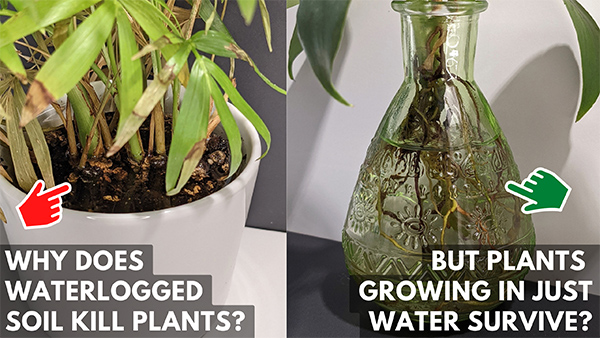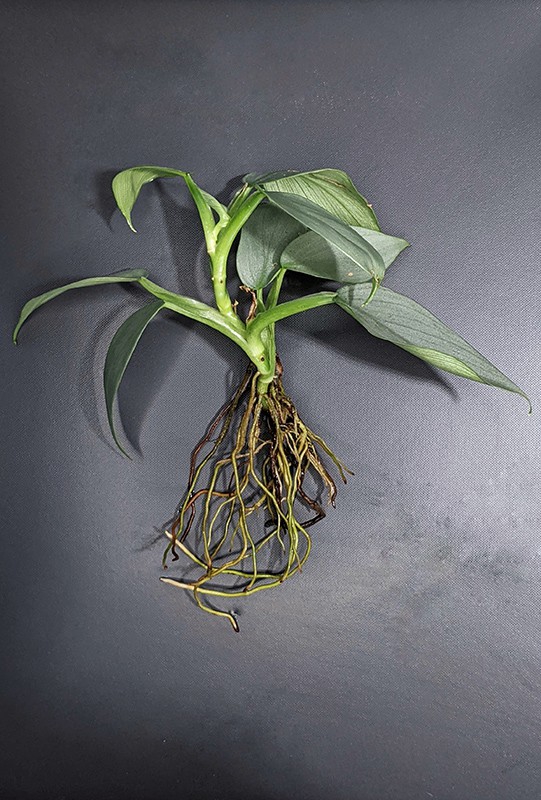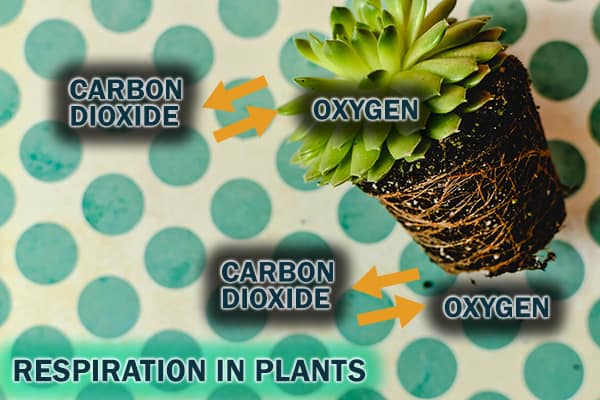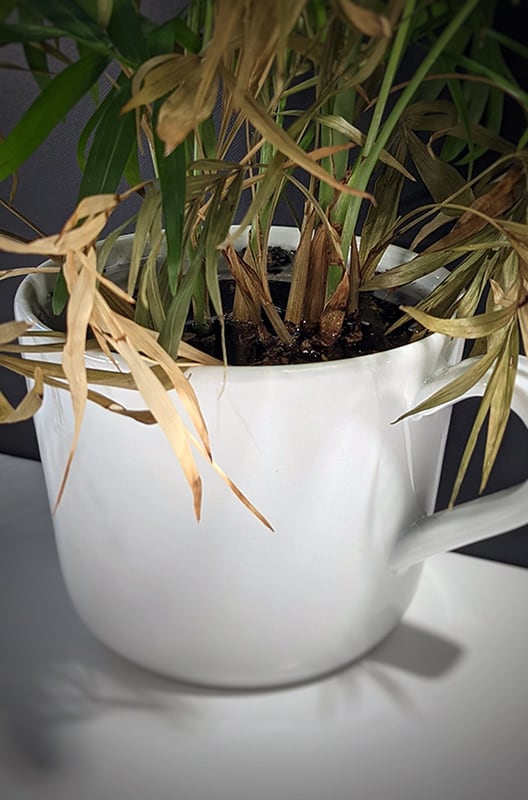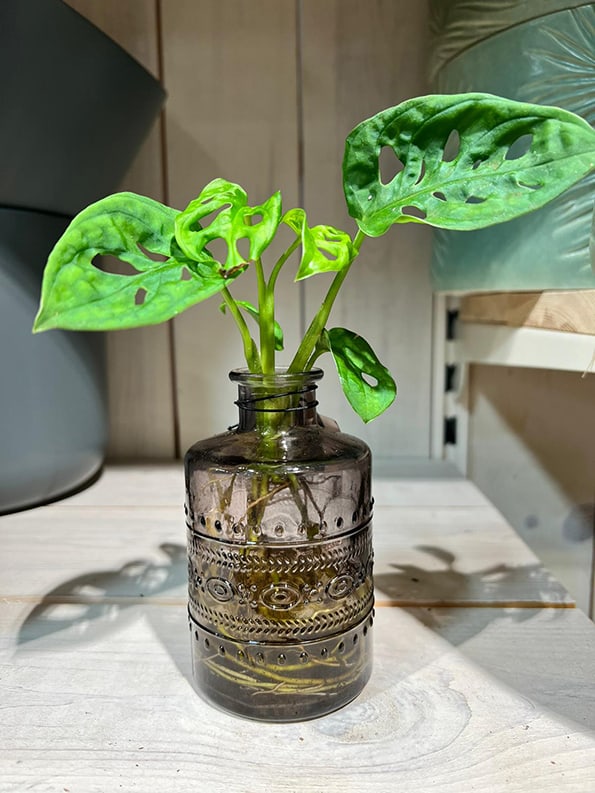When grown in a growing medium like soil, you can easily overwater houseplants by mistake causing root rot and after a short time, your plant could be gone.
But if you put a cutting, or even a fully rooted indoor plant, into a container or vase of just water, they can survive, produce new growth, and flourish for years.
So why does the overwatered houseplant growing in soil die?
On the left is a sickly houseplant with poor drainage. On the right is a plant surrounded by water but has very healthy roots. Why is this happening?
The simple and quick answer is that the growing environments between a waterlogged soil potting mix with no drainage holes and a container filled with just water are very different.
There is more to it though and I'm going to explain it all, while keeping it as easy to follow as possible.

Hi, I'm Tom!
If you're like me and enjoy the challenge of growing houseplants and getting them to thrive, then Ourhouseplants can help. This website shares my knowledge and years of growing plants and provides (hopefully) helpful advice on properly caring for your indoor plant friends.
Basically it all comes down to the roots of the plant. What they do and how they interact with the potting soil or growing medium.
Generally speaking, all healthy plants look like this. Foliage at the top then a root ball with healthy roots at the bottom.
Thinking back to your Biology lessons at school, you'll know that the root hairs on plant roots absorb water by a type of diffusion called Osmosis. You would have been taught that the plant then transports this water to the leaves in tubes called xylem to be used in photosynthesis.
The leaves then take in Carbon Dioxide (CO2) and release Oxygen in what is known as gas exchange. The CO2 is then used in photosynthesis to create carbohydrates that the plant can use for energy. This is all true, but is only part of the story.
Like humans, all parts of the plant have cells that need the carbohydrates to provide energy, but plants don't have a circularity system like people, so moving this around the plant isn't as quick. Sure they can do it; it's called "translocation", but it's not the most efficient way of doing things.
Photosynthesis vs Respiration
Photosynthesis is the production of carbohydrates and only happens in the presence of light.
Respiration is the process of breaking down these carbohydrates and turning them into usable energy. This can happen at any time, day or night.
To solve this, most plants have areas that can perform multiple functions, including respiration, where cells break down carbohydrates into sugars. This means potential energy is always close to the parts of the plant that need it.
The catch is that respiration is a chemical process and it requires oxygen to be present, to work.
You might also remember learning that plants cannot easily transport gases around themselves, which is also true. So how do cells in the plant roots and surrounding areas get the Oxygen they need to break down the nearby sugars?
The answer is that gas exchange and plant respiration happen not only in the leaves but also through the root system.
Both the leaves AND the roots take in Oxygen and release C02 during Respiration - Photo by Eva Bronzini
What does all this mean in summary?
Roots can absorb Oxygen from the surrounding growing medium so cells within the roots can carry out root respiration. That could be oxygen from the air pockets naturally present between the soil particles or from the oxygen found in water.
The second point is that almost all soil types contain bacteria and fungi. Even sterilized mixes will eventually attract and harbor these organisms.
This might sound worrying, but for the most part, the bacteria are benign to plants and humans. There is actually a very harmonious relationship between the plant and the fungi in the root zone, known correctly as a "symbiotic relationship" or "mycorrhiza".
Certain fungi attach and grow on the root hairs and protect the plant from disease, harmful bacteria, give resistance to toxic buildups and help it absorb minerals and nutrients. In return, the root hairs provide carbohydrates, such as glucose, to the fungi. Everyone wins!
So what happens when good drainage goes out of the window and you're guilty of too frequent watering?
In mild cases you might find you have to deal with yellow leaves or fungus gnats, but when you really over do it, the soil becomes waterlogged.
There are two main reasons why waterlogging is bad news for our houseplant friends.
It's not good news for this Parlour Palm. Without any drainage holes in this planter, excess water has now built up around the root ball and is almost overflowing.
When there is too much water in the growing medium and not enough can escape from the bottom of the pot, it seeps out of the material particles and into the small gaps that are filled with air.
This air is displaced and the amount of oxygen available to the roots is drastically reduced. This type of growing environment is known as hypoxic.
The plant cells in the submerged sections still receive carbohydrates because the plant moves them around.
But, effective respiration, which breaks down these sugars into usable energy, in this area of the plant is reduced as the necessary elements are missing or in short supply due to the waterlogging.
Your houseplant can adapt and react to this problem by deploying different ways to gain energy. The plant starts temporary survival mechanisms and goes into a type of survival mode and everything slows down. This is why most houseplants can deal with brief periods of waterlogging.
However, all of these rapid changes often cause plant stress and weaken it.
The symbiotic relationship can't function properly in the presence of so much water, so the benefits the fungi and the plant receive are lost for as long as the growing medium remains waterlogged.
As mentioned earlier, one benefit is immunological protection from harmful bacteria and some resistance to toxicity. With the growing medium submerged, various bacteria and tiny animals (nematodes) can take advantage of the situation and quickly colonize in the new growing conditions.
Without the presence of air, the type of bacteria is typically "Anaerobic". This means they're generating their energy without oxygen and this process has toxic byproducts that seep into the area.
If you ever notice overwatering in a container without drainage holes, the water stays put, and this is why when you attempt to pour the water away, it will often be pungent or foul smelling.
Exceptions
Not all houseplants suffer in waterlogged soil. Any that have aquatic or semi aquatic adaptations can cope and avoid root damage. This includes Moss Balls, Umbrella Grass and, bog plants like Pitcher Plants or the Venus Flytrap.
It doesn't take long before the growing medium becomes unhealthy. The plant is under stress from reduced respiration levels, and the protection from the beneficial fungi isn't working. The harmful anaerobic bacteria can attack the weakened roots at this point, and root rot quickly sets in.
Before too long, your plant starts to show significant symptoms of a problem. Such as falling, wilting or yellowing leaves. All of this can happen in just a few days and once root rot progresses, it's just a matter of time before your plant dies.
Even though the situation is similar (roots surrounded by water), growing indoor plants in just water, known as hydroponics, can give vastly different outcomes to plants growing in wet soil. In fact some plants can grow happily in water for years.
Further reading -
How to Grow Houseplants in Water
So how is this possible? It's surprisingly simple.
In most cases, you grow plants in water as a form of propagation, a process known as "striking." All you do is take cuttings from the mother plant and then pop the stem into a vase of water. All being well, the cutting establishes itself and becomes a new plant.
This type of cutting causes extreme damage and is a form of "wounding". The cells within the cutting work to repair the damage and grow a replacement root network.
The new roots that form early on are primarily adventitious roots. It's been shown that these adventitious roots can absorb oxygen directly from the water. This means that normal respiration can take place, allowing the cutting to grow rapidly and establish itself.
Earlier we explained that good plant health is supported by beneficial fungi found in most growing mediums.
Obviously, there won't be any fungi in a tap water-only environment. So although there will be no symbiotic relationship establishing, the benefits it would typically provide in a soil environment aren't needed anyway.
In almost all cases, the water being used in the vase will be clean so there should be little to no bacteria present. This means the cutting can grow and thrive without the threats a soil based setup would introduce.
Providing you change the water every week or so, you shouldn't get any problems.
To keep it this way, you just need to make sure you change the water every week or two to help keep things fresh and clean. Provide enough light for the plant to grow, but try to avoid low light and direct sunlight, which can encourage algae to build up.
When you started researching this topic, you might have encountered the following incorrect reasons why houseplants die in waterlogged soil. They're wrong, though and here's why.
"The roots are different between soil grown and water grown plants. This is why water propagated plants die when moved into soil".
The logic initially makes sense. In water only situations plants typically do grow more adventitious roots than if they were growing in soil.
But they don't only grow adventitious roots, and these types of roots don't only take oxygen from the surrounding water. i.e., they are quite capable of performing other functions in soil too.
The second part of the statement is also false. It's fair to say that, yes, some plants won't make the transition from water to the soil. But in almost all cases, they will. Failure is almost always down to a cultural growing problem, or even the soil being too wet (a waterlogged plant!!).
"The nutrients and minerals are washed out of the soil and the plant starves".
Yes too much water might displace nutrients near the root hairs of the plant, but almost all plants can cope with nutrient poor soils or no nutrients at all for a time.
It's not healthy in the long term I agree, but it would take months and months for nutrient deficiency symptoms to show up. In comparison, serious overwatering problems could show up within a few days.
If you've read everything so far, you'll already know that waterlogged soil damages houseplants because of the lack of oxygen. Additionally, this environment allows bacteria to build up, damaging the plant's roots and leading to fungal disease like root rot.
These problems are much less likely for plants growing in just water, providing you change the water frequently. So what are my top tips for avoiding root rot?
So hopefully, I've fully answered why plants die from overwatering in waterlogged soil, but can live in only water with no issues. Still confused? Have follow up questions? Post them in the comments below and I'll get back to you.
